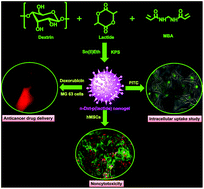Dextrin and poly(lactide)-based biocompatible and biodegradable nanogel for cancer targeted delivery of doxorubicin hydrochloride†
Abstract
Herein, we report the development and application of a novel biocompatible, chemically crosslinked nanogel for use in anticancer drug delivery. The nanogel [n-Dxt-p(lactide)] has been synthesized from dextrin and poly (lactide) by in situ crosslinking with a homobifunctional crosslinker through a conventional radical polymerization technique. The properties of the nanogel have been investigated using FTIR spectroscopy, 1H NMR spectroscopy, TGA, FESEM, TEM and DLS. The stimuli responsiveness of the nanogel has been detected by measuring its pH dependent swelling in different buffer solutions at 37 ± 0.5 °C. It was found that the size of nanogel was less than 10 nm. Degradation experiments using hen egg lysozyme revealed that the nanogel is biodegradable. In vitro cytocompatibility studies against human mesenchymal stem cell (hMSCs) suggested that the nanogel is non-toxic. The nanogel can efficiently load and encapsulate doxorubicin hydrochloride (Dox) within the matrix with 28.26 ± 0.20% loading efficiency and 91.16 ± 0.64% encapsulation efficiency. Additionally, the native nanogel showed non-toxic effects on MG 63 cancer cells, while Dox-loaded nanogel demonstrated high toxicity towards cancer cells. Because of its very small size, the nanogel can effortlessly enter into the cell cytoplasm and destroy cancer cells. The n-Dxt-p(lactide) nanogel released doxorubicin in a sustained manner and appears to be a high-quality option for doxorubicin hydrochloride delivery.



 Please wait while we load your content...
Please wait while we load your content...